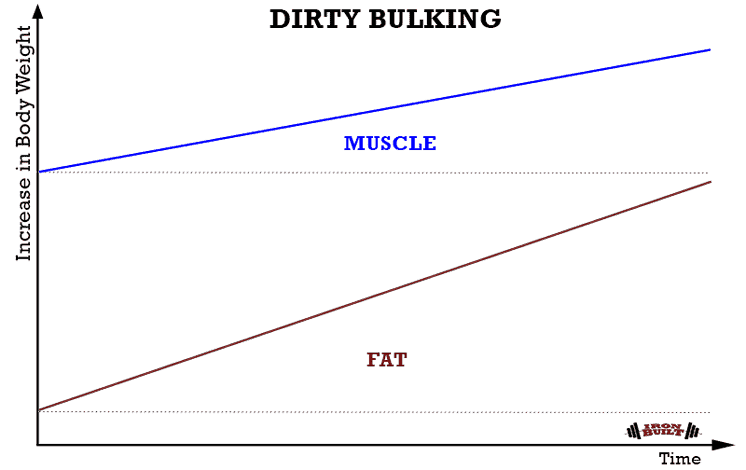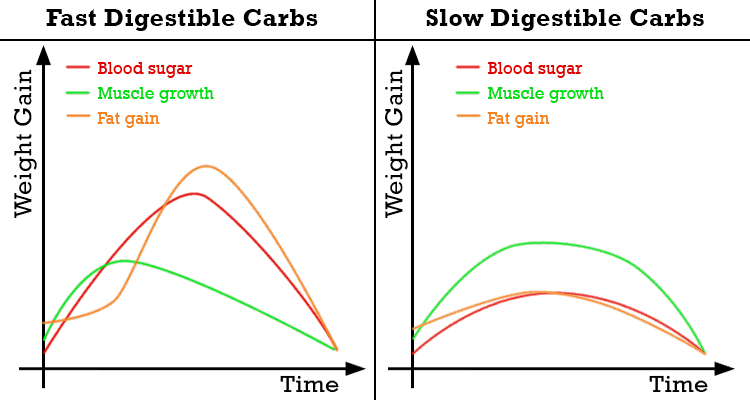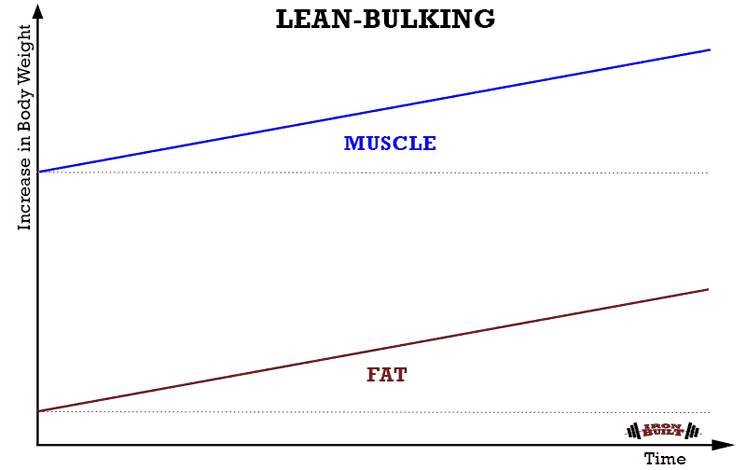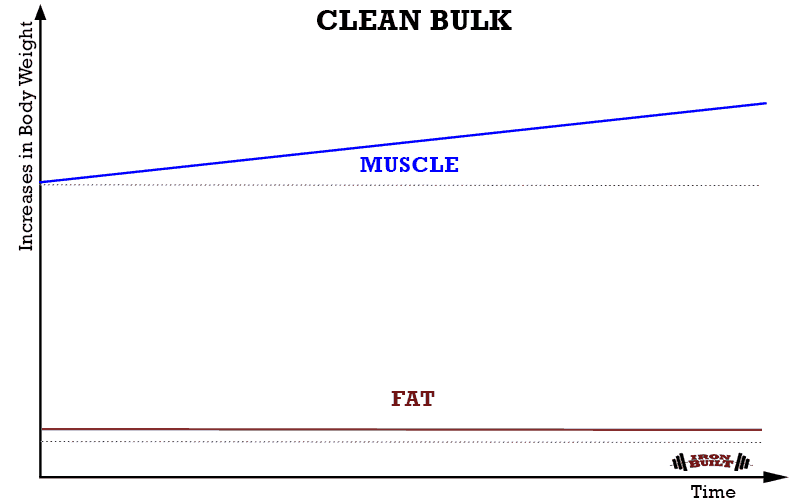
I remember when I first got started with my fitness journey five years ago. And boy was I confused about the sheer overload of information out there. One of the things that confused me was the topic of bulking.
Some people said that you should eat a ton no matter where the food came from, i.e dirty bulking. While others said that you should take a slower approach when bulking, i.e lean bulking or clean bulking. In this post I want to clear out any confusion about the concept of bulking. Starting by answering the question:
Is dirty bulking worth it? No, dirty bulking is far from worth it. In fact, dirty bulking leads to a ton of unnecessary fat gain and it’s also an extremely unhealthy approach to dieting. A much better approach would be to do a lean bulk or clean bulk instead.
In this post I’ll answer more in depth what dirty bulking is, why it’s a “too good to be true” strategy and finally I’ll cover two great bulking alternatives to use instead.
Let’s go!
Table of Contents
What is Dirty Bulking?
Dirty bulking is basically a strategy where your goal is to eat as much as possible, following no real nutritional guidelines other than just trying your best to get a ton of calories down your gut. There is no distinction between nutritious food and junk food. In other words, calories are calories and the sole purpouse of the dirty bulk is to cram as much calories as you can.
The strategy is mostly recommended for skinny people who have a hard time gaining weight, i.e. the hardgainer. And proponents of this bulking strategy often encourage people by saying that they will pack on slabs of new muscle mass simply by stuffing their face with whatever the hell they want.
The dirty bulk welcomes eating burgers, pizza, fries, ice cream, and all the other usual no-no foods. If you want to go to an all-you-can-eat-buffet and stuff your face until you’re close to vomiting that’s a sign of success on this protocol.
If this sounds like a good plan, then I’m sorry to break it to you, but it’s not.
The Dirty Bulk is too Good to be True
Even though the basis of dirty bulking is true; that hardgainers must take in more calories than the average trainee, it doesn’t mean that the hardgainer should consume extreme amounts of calories. Unfortunately, dirty bulking is just another “too good to be true” idea in the fitness industry.
Sure, one can grow muscle on this type of diet, but not only is it far from optimal when it comes to muscle growth, it also has the potential to add way too much body fat while also being an incredibly unhealthy approach to dieting.
The 2 Reasons Why You Should Avoid Dirty Bulking
Basically, there are two big reasons why you should avoid dirty bulking even though you might struggle as a hardgainer. Let’s look at these one by one:
1. Too Large Calorie Surplus
The biggest problem with the dirty bulk is that it usually leads to a calorie surplus that’s way too large to only support muscle growth. In fact, there’s a limit to how much muscle you can build, and any amount of calories that you eat above this limit will lead to fat gain.
Even hardgainers might eventually start gaining too much fat when following a dirty bulking protocol, simply because it’s not uncommon that people successfully eat 1000-2000 calories more per day than what they needed to maintain their current body weight. And this amount of energy is a lot more than what’s needed to maximize muscle growth.
And eating too many calories are:
- Unsustainable – You will need to go on a cut very soon to get rid of the excessive body fat that you have gained. A high body fat percentage has also been shown to reduce your ability to build muscle.
- Unnecessary – Eating so much that you need to constantly cut body fat is very unnecessary as you’ll just spin your wheels in the gym get nowhere.
- Unhealthy – Gaining weight too quickly, especially fat, is very unhealthy to the body.
How Fast Can You Truly Build Muscle?
To get a grip of how much calories you should consume to maximize muscle growth, let’s look at some muscle building theory.
How you should set up your caloric surplus to gain muscle is highly associated with training experience. By categorizing training age, you can get a pretty accurate estimation of how much muscle you can build in a month. Here’s a rough estimate of how much muscle you can build per month if you do everything correct with your training:
| Years of Training | Maximum Muscle Growth Potential |
|---|---|
| Year 1
Year 2 Year 3 Year 4 Year 5+ |
20-25lbs (2lbs per month) / 9 – 11 kg (0.9kg per month)
10-12lbs (1lbs per month) / 4.5 – 5.5 kg (0.45kg per month) 5-6lbs (0.5lbs per month) / 2 – 2.7 kg (0.22kg per month) 2-3lbs / 0.9 – 1.3 kg 2-3 lbs / 0.9 – 1.3kg |
Lyle McDonald’s model of average maximum rate of muscle gain.
- Beginners (year 1) that already are fairly muscular (maybe from a lifetime of sports or heavy manual labor) can probably expect the same muscle growth as an intermediate (year2-3)
How Much Energy is Required to Build Muscle?
People that are a lot smarter than myself, have figured out that in theory it requires around 2500 calories to build 1 lb (0.5 kg) of muscle.
This means that the ideal calorie surplus for a beginner should be 5000 calories per month since they can build around 2 pounds of muscle per month. However, in most cases, more calories than this is required to maximize muscle growth. And this seems to be somewhere around double this number. So, if we double 5000 we end up with a 10000 calorie surplus per month, which equals a surplus of 330 calories per day.
As you can see, 330 calories above maintenance is far less than the common 1000-2000 calories above maintenance that is usually eaten when someone’s on a dirty bulk.
For illustrative purposes here’s a graph showing you the excessive fat gain as opposed to muscle mass gained overtime when using a dirty bulk:

As you can see, your rate of fat gain is much quicker than your rate of muscle gain, which is unsustainable, unnecessary and even unhealthy.
2. Too Much Junk Food
The second reason why you should avoid the dirty bulk strategy is because it usually advocates that you can eat whatever you want in order to gain weight. Including junk food such as chocolate, candy, donuts, chips and ice cream etc.
Now, even though these kind of food sources are high in calories, which could help you grow muscle, they are called junk food for a reason.
Junk food is typically composed of simple, processed, and low-fiber carbohydrate sources that take your blood sugar and insulin levels on a roller coaster ride that will eventually lead to insuline resistance. If your body becomes insulin resistant, not only are you in a pre-stage of developing diabetes (especially in combination with a high calorie intake), but you’re also going to have a hard time shuttling nutrients to your muscle cells. This will ultimately translate to lowered training performance in the gym.
Not only that, these simple and fast digestible carbs won’t provide you with a steady supply of energy long-term, which is bad for muscle growth. On the other hand, complex and slow digestible carbs will provide you with a steady supply of energy, which is great for muscle growth.
Let me explain what I mean by using two different scenarios as examples:
Example 1: A meal with 1000 calories composed of fast digestible carbs:
Let’s say that you eat 1000 calories of fast digestible carbs. After you’ve eaten these carbs your digestive system will quickly push them out in your blood stream as glucose. Once the glucose is in your blood stream the body must either use it as energy or store it as energy for future use. For muscle growth specifically, we want as much of the glucose as possible to be used to fuel the muscle building process (muscle protein synthesis).
The problem with fast digestable carbs is that during very few circumstances is your body going to be able to handle 1000 calories of carbs released into the blood stream within a very short time period, which would be the case when eating fast digestible carbs. So, out of these 1000 calories, perhaps 200 of them will be used by your muscle building process while the remaining 800 will go towards fat storage. (Just using an orbitrary number to express my point)
In other words, eating fast digestible carbs is highly ineffective for muscle growth during most circumstances. Exceptions to this would be after a long endurance training session where you burned a ton of energy. But, as a strength trainee looking to pack on muscle mass, fast digestible carbs in high quantities are almost always unnecessary.
Example 2: A meal with 1000 calories composed of slow digestible carbs:
So, let’s say that instead of fast digestible carbs you eat 1000 calories of slow digestible carbs. Carb sources such as brown rice, whole-grain pasta and vegetables etc. takes a long time for your body to transform into glucose. This means that when you eat these carbs you create a steady supply of perhaps 200 calories per hour, which is something that the muscle building process (muscle protein synthesis) can better keep up with.
In other words, eating slow digestible carbs is highly effective for muscle growth. Where the majority of energy will go towards building muscle instead of getting stored as body fat.
Here’s a loose illustration of this concept:

*This is just a simplification of the process to convey my point
As you can see, a diet that is composed mainly of fast digestible carbs will result in less muscle growth and more fat gain, while a diet that is composed mainly of slow digestible carbs will result in more muscle growth and less fat gain.
And this is just when talking about carbs, the types of fats you eat also has an impact on your rate of muscle growth and how healthy your body is. But that would be a whole other discussion. In short, unsaturated fats from a wholesome, nutrient dense diet is better for muscle growth and health than what saturated fats are.
So, I can’t eat any junk at all?
No, I’m not saying that you need to exclude all junk food from your diet. Junk food is part of our culture and is something that should be enjoyed, but in moderation.
I always recommend sticking to the 80/20 rule of dieting where 80% of your diet should be composed of wholesome nutrient dense food, and the remaining 20% can come from junk food. If you want to read more about how to include junk food when bulking you can do so here.
The Two Better Bulking Strategies
Okay, so dirty bulking is not worth it! You should avoid dirty bulking as it will only lead to excessive fat gain, less muscle growth and potentially cause ill-health.
So, instead what you should do is using one of the following two bulking strategies.
The Lean Bulk
With this bulking strategy you’ll maximize muscle growth while allowing for only moderate amounts of fat to be stored.
If you truly want to build muscle as a beginner to intermediate trainee (0-4 years), don’t be afraid of gaining some body fat. It’s really not that bad in the grand scheme of things.
When you allow for some fat storage, you’ll have a high enough calorie surplus for the hormonal environment in your body to favor maximum muscle growth. But at the same time, you’re not gaining too quickly. This allows you to avoiding unnecessary fat gain that you would have gained following a dirty bulk strategy.
The calorie surplus I recommend is one that allow you to gain at a 1-1 ratio, or slightly below, of muscle and fat. For illustrative purposes here’s a graph showing you the ideal rate of fat gain and muscle gain if you want to maximiuze muscle growth without gaining unnecessary fat in the process:

As you can see, your rate of fat gain is the same as your rate of muscle gain, which leads to maximized muscle growth without unsustainable, unnecessary and unhealthy fat gain.
Should You Lean Bulk?
I recommend lean bulking for 80-90 % of beginner to intermediate trainees. If you’ve been training productively for 0-4 years and are looking to add muscle mass as quickly as possible, without gaining too much fat, this is the method to use.
You can read more about how to set up your calorie surplus for this kind of bulk here.
The Clean Bulk
With this bulking strategy, the goal is to slowly gain muscle without gaining fat. Which is a great goal!
But, there are three big drawbacks with this strategy:
- It’s extremely hard to notice progress and changes too your physique because building new muscle tissue takes a long time. In fact, looking for gains in muscle mass is like watching paint dry. With the clean bulk strategy, the only guidelines you have to depend is your progress in the gym, meaning that the volume and weights you’re training with increases over time.
- You can’t maximize your muscle building potential. This is because the hormonal environment in your body won’t be optimized for muscle growth. (This is true only for beginners and intermediates.)
- The clean bulk often advocates no junk food at all. And I believe this is a problem, mainly because junk food is part of life! It’s been shown that having 10-20% of your diet come from junk food is completely fine when bulking.
For illustrative purposes here’s a graph showing you what the changes in body weight would be using a clean bulk:

As you can see, you’re gaining very little to no fat, but your muscle building potential is reduced a bit as well.
Should You Clean Bulk?
The ones I recommend this method for are individuals with a lot of training experience, who have multiple years of training under their belt.
Like WNBF Pro Natural Bodybuilder Jeff Nippard for example:

These individuals are close to their genetic potential when it comes to muscle growth. So, they need only a very small calorie surplus seen over multiple months, even years to build any new muscle tissue.
I would also recommend this method for individuals that really don’t want to add any fat to their frame, such as actors or professional models that must be in shape year-round for movie roles or photo shoots etc. Or if you simply just want to stay lean as you build your physique.
You can read more about how to set up your calorie surplus for this kind of bulk here.
What’s Next?
In short, dirty bulking is not a viable strategy for gaining weight and building muscle. If you want the best results possible you should use either the lean bulk or the clean bulk. The problem with these approaches is that they both require you to be more in control of what you’re eating.
To do this I recommend that you get your hands on more premium information that will teach you how to set up your diet to ensure that you reach your goal as quickly and effectively as possible. And when it comes to lean-bulking I recommend Radu’s ShredSmart Program.
You can read more about why I recommend Radu’s program in this post.
